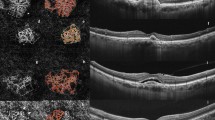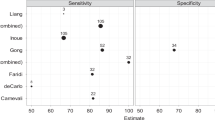Abstract
Purpose
To investigate whether examination with the non-invasive optical coherence tomography (OCT) alone is sufficient to ascertain the need of re-treatment with bevacizumab for exudative age-related macular degeneration (AMD) or the invasive fluorescein angiography (FA) is needed.
Method
Two independent examiners reviewed FA and OCT images and performed a semi-quantitative assessment from 0=no activity to activity 1–3, mild, moderate and advanced, respectively. Weighted Kappa indices were performed to calculate the concordance between OCT and FA.
Results
A total of 153 OCT and FA examinations of 69 patients were evaluated, mean 2.2 examinations per patient. The mean age was 77.1±7.9 (55–89) years; 29.0% were male, 71.0% female. The weighted Kappa index showed concordance for activity in OCT and FA weak concerning the first investigation 4–6 weeks after initial treatment (0.3847) and obvious concerning the second investigation 8–10 weeks after initial treatment (0.4170). Higher values of activity were found with the OCT compared to FA. The most frequent reasons for discrepancies were detachment of the pigmentepithelium and fibrosis.
Conclusion
There is evidence of agreement between both examinations, the OCT was even more sensitive to detect activity of a lesion. In conducting studies based on OCT as single examination, it should be clearly defined how long fibrotic lesions or lesions with pigment epithelial detachment should be re-treated.

Similar content being viewed by others
References
Avery RL, Pieramici DJ, Rabena MD et al (2006) Intravitreal bevacizumab (Avastin) for neovascular age-related macular degeneration. Ophthalmology 113:363–372
Bashshur ZF, Bazarbachi A, Schakal A et al (2006) Intravitreal bevacizumab for the management of choroidal neovascularization in age-related macular degeneration. Am J Ophthalmol 142:1–9
Bressler NM, Treatment of Age-Related Macular Degeneration with Photodynamic Therapy (TAP) Study Group (2001) Photodynamic therapy of subfoveal choroidal neovascularization in age-related macular degeneration with verteporfin: two-year results of 2 randomized clinical trials-tap report 2. Arch Ophthalmol 119:198–207
Fung AE, Lalwani GA, Rosenfeld PJ et al (2007) An optical coherence tomography-guided, variable dosing regimen with intravitreal ranibizumab (Lucentis) for neovascular age-related macular degeneration. Am J Ophthalmol 143:566–583
Holz FG, Jorzik J, Schutt F et al (2003) Agreement among ophthalmologists in evaluating fluorescein angiograms in patients with neovascular age-related macular degeneration for photodynamic therapy eligibility (FLAP-study). Ophthalmology 110:400–405
Krebs I, Binder S, Stolba U et al (2005) Optical coherence tomography guided retreatment of photodynamic therapy. Br J Ophthalmol 89:1184–1187
Macular Photocoagulation Study Group (1991) Subfoveal neovascular lesions in age-related macular degeneration. Guidelines for evaluation and treatment in the macular photocoagulation study. Arch Ophthalmol 109:1242–1257
Moshfeghi AA, Rosenfeld PJ, Puliafito CA et al (2006) Systemic bevacizumab (Avastin) therapy for neovascular age-related macular degeneration: twenty-four-week results of an uncontrolled open-label clinical study. Ophthalmology 113:2002.e1–e12
Rich RM, Rosenfeld PJ, Puliafito CA et al (2006) Short-term safety and efficacy of intravitreal bevacizumab (Avastin) for neovascular age-related macular degeneration. Retina 26:495–511
Sandhu SS, Talks SJ (2005) Correlation of optical coherence tomography, with or without additional colour fundus photography, with stereo fundus fluorescein angiography in diagnosing choroidal neovascular membranes. Br J Ophthalmol 89:967–970
Talks SJ, Koshy ZR, Chatzinikolas K (2007) The use of optical coherence tomography, flourescein angiography and indocyanine green angiography in a screening clinic for wet age-related macular degeneration. Br J Ophthalmol 91:600–601
Treatment of Age-Related Macular Degeneration with Photodynamic Therapy (TAP) Study Group (1999) Photodynamic therapy of subfoveal choroidal neovascularization in age-related macular degeneration with verteporfin: one-year results of 2 randomized clinical trials-TAP report. Arch Ophthalmol 117:1329–1345
Verteporfin Roundtable Participants (2005) Guidelines for using verteporfin (Visudyne) in photodynamic therapy for choroidal neovascularization due to age-related macular degeneration and other causes: update. Retina 25(2):119–134, Feb–Mar
Yoganathan P, Deramo VA, Lai JC et al (2006) Visual improvement following intravitreal bevacizumab (Avastin) in exudative age-related macular degeneration. Retina 26:994–998
Conflict of interest statement
None of the authors has a financial interest that is related to the manuscript.
Author information
Authors and Affiliations
Corresponding author
Additional information
Supported by unrestricted research grant from the L. Boltzmann Institute to SB.
The authors have full control of all primary data and they agree to allow Graefes Archive for Clinical and Experimental Ophthalmology to review their data upon request.
Rights and permissions
About this article
Cite this article
Krebs, I., Ansari-Shahrezaei, S., Goll, A. et al. Activity of neovascular lesions treated with bevacizumab: comparison between optical coherence tomography and fluorescein angiography. Graefes Arch Clin Exp Ophthalmol 246, 811–815 (2008). https://doi.org/10.1007/s00417-007-0755-6
Received:
Revised:
Accepted:
Published:
Issue Date:
DOI: https://doi.org/10.1007/s00417-007-0755-6




